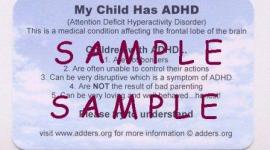An Inclusive Learning Handbook for Prisons and Young Offender Institutions
Unrecognised Dyslexia and the Route to Offending
A study completed for the British Dyslexia Association has found that there are many links between undiagnosed dyslexia and the criminal justice system. This could also have some major implications for those with ADD/ADHD so we have decided to add the report of this study to the ADD/ADHD Research Pages here so that people can possibly investigate a bit further.
To read the full study Click Here
Also whilst checking through various UK Government Sites I found a really useful document called "An Inclusive Learning Handbook for Prisons and Young Offender Institutions" which has some very interesting sections concerning ADHD, including YO Institutes Teaching ADHD Guidelines.
To read this Click Here
Foreword In recent years a number of projects and studies has identified a link between dyslexia and offending. A much higher incidence of dyslexia, usually between 30% and 50% have been found amongst offenders compared with and incidence of 10% in the general population. Yet appropriate educational support of dyslexic offenders remains the exception rather than the rule.
As a result, the BDA recently established work with offenders as a key strategic theme and were delighted to be able to work alongside Bradford Youth Offending Team to examine the issue with young offenders. The establishment of the Youth Justice Board and YOTs and the added commitment to supporting the education of young offenders gives us a real opportunity to improve support for dyslexic offenders and reduce offending.
The BDA has gained from its partnership with Bradford YOT and developed a valuable insight to support the work of the YOT. Now we move forward to disseminate and further develop this work, this report is key to doing that.
Finally, I would like to thank the staff at Bradford YOT and many of their partner agencies, including Education Bradford, for their support with this work. I would also like to thank JJ Charitable Trust and Tudor Trust, whose funding made this project possible.
Steve Alexander, Chief Executive, British Dyslexia Association
Executive Summary
There is evidence of a "route to offending" among certain young people, which starts with difficulties in the classroom, moves through low self-esteem, poor behaviour and school exclusion, and ends in offending.
Children and young people with dyslexia are more likely fall onto this route, because of the difficulties they face with learning.
The broad aim of this project is to examine the processes of the Youth Justice system and highlight the issues associated with dyslexia amongst young offenders. Whilst it was expected that the incidence of dyslexia amongst the sample of young people screened would be high, the real value of this work would be in the recommendations that would be made to identify and support dyslexic young offenders within the system.
The project found that there were particular 'hot spots' in the system at which knowledge of a young person's dyslexia was critical to the best action being taken. These included the support given by an Appropriate Adult, Presentence Reports and the use of ASSET. Also, a particularly difficult problem to solve is that so many young offenders are not formally excluded form school but do not attend. This leaves the funding for their education locked in the school system, while voluntary income is used to develop projects to engage them positively in the community.
A sample of 34 young offenders was screened for dyslexia and 19 were categorized as dyslexic, an incidence of 56%.
The incidence of dyslexia appeared to increase with the severity of the offending. Reading ages were generally much lower than chronological ages and informal contact with the sample highlighted low self-esteem. Of the 19 young people in the dyslexic group, 7 had a statement of Special Educational Need, but they all related to behavioural problems, not dyslexia.
The project offered a number of interventions in addition to the screening. These included ICT based literacy support for individuals, training for staff at the YOT and partner agencies that work with the YOT.
This project adds weight to evidence that suggests that there is a much higher incidence of dyslexia amongst offenders. Appropriate screening, assessment and intervention will help these young people to build selfesteem and break out of the cycle of re-offending.
The BDA calls on all Youth Offending Teams to study its findings and implement the recommendations made.
APA Reference
Staff, H.
(2008, December 22). An Inclusive Learning Handbook for Prisons and Young Offender Institutions, HealthyPlace. Retrieved
on 2026, January 1 from https://www.healthyplace.com/adhd/articles/an-inclusive-learning-handbook-for-prisons-and-young-offender-institutions
